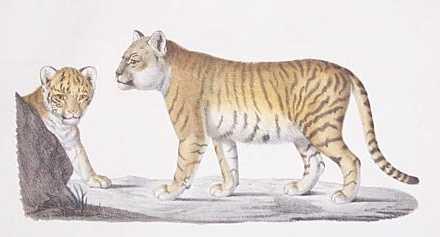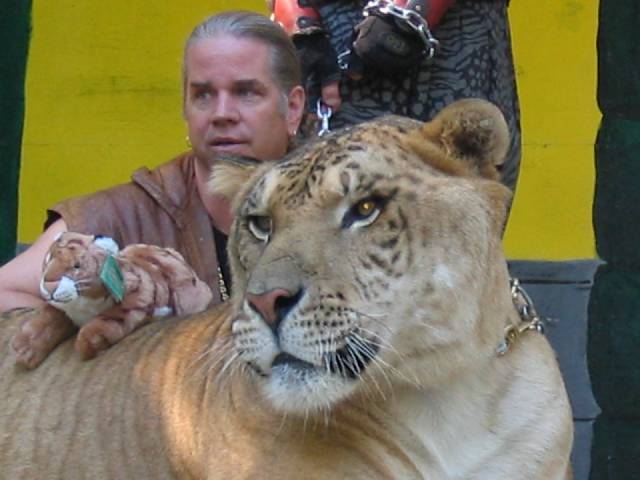|
Tigon
A tigon (), tiglon () (portmanteau of ''tiger'' and ''lion''), or tion () is the hybrid offspring of a male tiger (''Panthera tigris'') and a female lion (''Panthera leo'').Techné v6n3 – Patenting and Transgenic Organisms: A Philosophical Exploration Scholar.lib.vt.edu. Retrieved on 17 September 2013. They exhibit visible characteristics from both parents: they can have both spots from the mother (lions carry genes for spots – lion cubs are spotted and some adults retain faint markings) and stripes from the father. Any mane that a male tigon may have will appear shorter and less noticeable than a lion's mane and is closer in type to the ruff of a male tiger. It is ... [...More Info...] [...Related Items...] OR: [Wikipedia] [Google] [Baidu] |
Liger
The liger is a hybrid offspring of a male lion (''Panthera leo'') and a female tiger (''Panthera tigris''). The liger has parents in the same genus but of different species. The liger is distinct from the similar hybrid called the tigon, and is the largest of all known extant felines. They enjoy swimming, which is a characteristic of tigers, and are very sociable like lions. Notably, ligers typically grow larger than either parent species, unlike tigons.Ligers messybeast.com Retrieved 4 September 2012. History The history of lion-tiger hybrids dates to at least the early 19th century in . In 1798, |
Liger
The liger is a hybrid offspring of a male lion (''Panthera leo'') and a female tiger (''Panthera tigris''). The liger has parents in the same genus but of different species. The liger is distinct from the similar hybrid called the tigon, and is the largest of all known extant felines. They enjoy swimming, which is a characteristic of tigers, and are very sociable like lions. Notably, ligers typically grow larger than either parent species, unlike tigons.Ligers messybeast.com Retrieved 4 September 2012. History The history of lion-tiger hybrids dates to at least the early 19th century in . In 1798, |
Litigon
A litigon (/ˌlaɪˈtaɪɡən/) is a rare, second-generation hybrid from a female tigon (a hybrid between a male tiger and a female lion) and a male lion, specifically an Asiatic lion. Description Litigons inherit and share characteristics with lions, the males sport manes and can also have rosettes. History The first attempt at breeding a litigon was successful; a female cub was born at the Alipore Zoo in Calcutta, India India, officially the Republic of India (Hindi: ), is a country in South Asia. It is the List of countries and dependencies by area, seventh-largest country by area, the List of countries and dependencies by population, second-most populous ... in 1971 to a female tigon named Rudrani and an Asiatic lion named Debabrata. Rudhrani went on to produce seven litigons, some of which reached impressive sizes: a litigon named Cubanacan (died 1991) was estimated to weigh least , stood at the shoulder, and was in total length. See also * Liliger References ... [...More Info...] [...Related Items...] OR: [Wikipedia] [Google] [Baidu] |
Alipore Zoo
The Zoological Garden, Alipore (also informally called the Alipore Zoo or Kolkata Zoo) is India's oldest formally stated zoological park (as opposed to royal and British menageries) and a big tourist attraction in Kolkata, West Bengal. It has been open as a zoo since 1876, and covers . It is probably best known as the home of the Aldabra giant tortoise Adwaita, who was reputed to have been over 250 years old when he died in 2006. It is also home to one of the few captive breeding projects involving the Manipur brow-antlered deer. One of the most popular tourist attractions in Kolkata, it draws huge crowds during the winter season, especially during December and January. The highest attendance till date was on January 1, 2018 with 110,000 visitors. History The zoo had its roots in a private menagerie established by Governor General of India, Richard Wellesley, established around 1800 in his summer home at Barrackpore near Kolkata, as part of the ''Indian Natural History Proj ... [...More Info...] [...Related Items...] OR: [Wikipedia] [Google] [Baidu] |
Tiger
The tiger (''Panthera tigris'') is the largest living cat species and a member of the genus ''Panthera''. It is most recognisable for its dark vertical stripes on orange fur with a white underside. An apex predator, it primarily preys on ungulates, such as deer and wild boar. It is territorial and generally a solitary but social predator, requiring large contiguous areas of habitat to support its requirements for prey and rearing of its offspring. Tiger cubs stay with their mother for about two years and then become independent, leaving their mother's home range to establish their own. The tiger was first scientifically described in 1758. It once ranged widely from the Eastern Anatolia Region in the west to the Amur River basin in the east, and in the south from the foothills of the Himalayas to Bali in the Sunda Islands. Since the early 20th century, tiger populations have lost at least 93% of their historic range and have been extirpated from Western and Central As ... [...More Info...] [...Related Items...] OR: [Wikipedia] [Google] [Baidu] |
Leopon
A leopon (portmanteau of ''leopard'' and ''lion'') is the hybrid offspring of a male leopard and a female lion. The head of the animal is similar to that of a lion while the rest of the body carries similarities to leopards. These hybrids are produced in captivity and are unlikely to occur in the wild. Description The first documented leopon was bred at Kolhapur, India, in 1910. Its skin was sent to Reginald Innes Pocock by Walter Samuel Millard, the Secretary of the Bombay Natural History Society. It was a cross between a large leopard and a lioness. Two cubs were born, one of which died aged 2.5 months, and the other was still living when Pocock described it in 1912. Pocock wrote that it was spotted like a leopard, but that the spots on its sides were smaller and closer set than those of an Indian leopard and were brown and indistinct, like the fading spots of a juvenile lion. The spots on the head, spine, belly and legs were black and distinct. The tail was spotted on ... [...More Info...] [...Related Items...] OR: [Wikipedia] [Google] [Baidu] |
Hybrid (biology)
In biology, a hybrid is the offspring resulting from combining the qualities of two organisms of different breeds, varieties, species or genera through sexual reproduction. Hybrids are not always intermediates between their parents (such as in blending inheritance), but can show hybrid vigor, sometimes growing larger or taller than either parent. The concept of a hybrid is interpreted differently in animal and plant breeding, where there is interest in the individual parentage. In genetics, attention is focused on the numbers of chromosomes. In taxonomy, a key question is how closely related the parent species are. Species are reproductively isolated by strong barriers to hybridisation, which include genetic and morphological differences, differing times of fertility, mating behaviors and cues, and physiological rejection of sperm cells or the developing embryo. Some act before fertilization and others after it. Similar barriers exist in plants, with differences in flowering t ... [...More Info...] [...Related Items...] OR: [Wikipedia] [Google] [Baidu] |
Lion
The lion (''Panthera leo'') is a large cat of the genus '' Panthera'' native to Africa and India. It has a muscular, broad-chested body; short, rounded head; round ears; and a hairy tuft at the end of its tail. It is sexually dimorphic; adult male lions are larger than females and have a prominent mane. It is a social species, forming groups called ''prides''. A lion's pride consists of a few adult males, related females, and cubs. Groups of female lions usually hunt together, preying mostly on large ungulates. The lion is an apex and keystone predator; although some lions scavenge when opportunities occur and have been known to hunt humans, lions typically don't actively seek out and prey on humans. The lion inhabits grasslands, savannas and shrublands. It is usually more diurnal than other wild cats, but when persecuted, it adapts to being active at night and at twilight. During the Neolithic period, the lion ranged throughout Africa and Eurasia from Southeast Euro ... [...More Info...] [...Related Items...] OR: [Wikipedia] [Google] [Baidu] |
Lion
The lion (''Panthera leo'') is a large cat of the genus '' Panthera'' native to Africa and India. It has a muscular, broad-chested body; short, rounded head; round ears; and a hairy tuft at the end of its tail. It is sexually dimorphic; adult male lions are larger than females and have a prominent mane. It is a social species, forming groups called ''prides''. A lion's pride consists of a few adult males, related females, and cubs. Groups of female lions usually hunt together, preying mostly on large ungulates. The lion is an apex and keystone predator; although some lions scavenge when opportunities occur and have been known to hunt humans, lions typically don't actively seek out and prey on humans. The lion inhabits grasslands, savannas and shrublands. It is usually more diurnal than other wild cats, but when persecuted, it adapts to being active at night and at twilight. During the Neolithic period, the lion ranged throughout Africa and Eurasia from Southeast Euro ... [...More Info...] [...Related Items...] OR: [Wikipedia] [Google] [Baidu] |
Portmanteau
A portmanteau word, or portmanteau (, ) is a blend of wordsGarner's Modern American Usage , p. 644. in which parts of multiple words are combined into a new word, as in ''smog'', coined by blending ''smoke'' and ''fog'', or ''motel'', from ''motor'' and ''hotel''. In , a portmanteau is a single morph that is analyzed as representing two (or more) underlying morphemes. When portmanteaus shorten established [...More Info...] [...Related Items...] OR: [Wikipedia] [Google] [Baidu] |
Felid Hybrid
A felid hybrid is any of a number of hybrids between various species of the cat family, Felidae. This article deals with hybrids between the species of the subfamily Felinae (feline hybrids). For hybrids between two species of the genus ''Panthera'' (lions, tigers, jaguars, and leopards), see Panthera hybrid. There are no known hybrids between ''Neofelis'' (the clouded leopard) and other genera. By contrast, many genera of Felinae are interfertile with each other, though few hybridize under natural conditions, and not all combinations are likely to be viable (e.g. between the tiny rusty-spotted cat and the leopard-sized cougar). All-wild feline hybridization Caracal × serval hybrids A '' caraval'' is a cross between a male caracal (''Caracal caracal'') and a female serval (''Leptailurus serval''), while a male serval's and female caracal's offspring are called ''servicals''. The first servicals were bred accidentally when the two animals were housed together at the Los ... [...More Info...] [...Related Items...] OR: [Wikipedia] [Google] [Baidu] |
Carl Hagenbeck
Carl Hagenbeck (10 June 1844 – 14 April 1913) was a German merchant of wild animals who supplied many European zoos, as well as P. T. Barnum. He created the modern zoo with animal enclosures without bars that were closer to their natural habitat. The transformation of the zoo architecture initiated by him is known as the Hagenbeck revolution. Hagenbeck founded Germany's most successful privately owned zoo, the Tierpark Hagenbeck, which moved to its present location in Hamburg's Stellingen district in 1907. He was also an ethnography showman and a pioneer in displaying humans next to animals in human zoos. Biography Hagenbeck was born on 10 June 1844, to Claus Gottfried Carl Hagenbeck (1810–1887), a fishmonger who ran a side business buying, showing, and selling exotic animals.46;Nigel Rothfels, ''Savages and Beasts: The Birth of the Modern Zoo''. (Baltimore: The Johns Hopkins University Press, 2002) When Hagenbeck was 14, his father gave him some seals and a polar ... [...More Info...] [...Related Items...] OR: [Wikipedia] [Google] [Baidu] |







